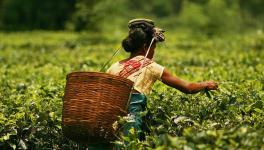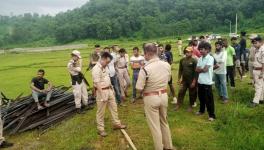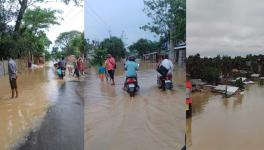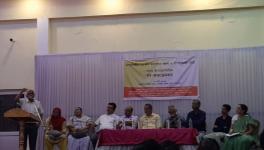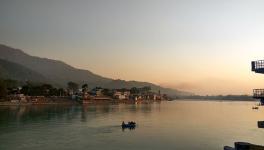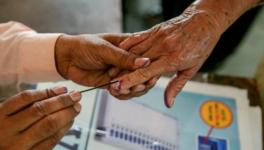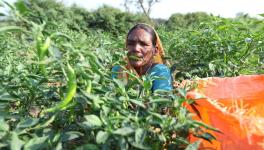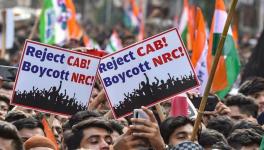Climate Change Turned Residents of Assam’s Char Villages Solely Dependent on Summer Crop
Mehar Ali (59) and his wife Yalunissa (55) are busy weeding the field of rice crop, which has grown to two-inch height in their one bigha (one-third of an acre) land in Baghmara village at the banks of Brahmaputra in Assam. They run a motor to pump water to the crop. They are hoping for good harvest, otherwise, it will be difficult for them to survive.
“I buy kerosene for Rs 90-100 per litre in black against its rate of Rs 85 per litre to run the motor. I cannot afford diesel. I have invested Rs 5,000 in tilling, ploughing, seeding and labour charges. I expect 5-10 tonnes of rice before rainfall begins in May-June,” he says.
Ali is counting on his summer harvest as he lost his kharif crop, a common misfortune in the ‘char’ villages in Bilasipura block of Dhubri district in the North-eastern state of India. The riverine areas Brahmaputra are locally known as ‘char’ or ‘chapori’. They are subjected to erosion on their upstream and deposition on the downstream. This affects the geography and location of the chars during floods almost every year, according to the Directorate of Char Areas Development.
Mehar Ali and his wife Yalunissa
Fourteen districts in Assam, along the Brahmaputra, have 2,251 char villages -- accommodating 24,90,097 people as per the Socio Economic Survey of 2003-04, which is the latest data available. The congested villages are backward and poverty-ridden. The population density in chars is 690 per sq km against Assam’s 340 per sq km. Cultivable land per capita is just 0.24 acres in these villages and the 19.31% literacy rate is lower than the state average 63%. The below poverty population in chars is 67%.
Like others, Ali’s kharif crop -- jute and paddy -- was washed away by the floods of the Brahmaputra river in July 2020. “Three flash floods from July to September carried away jute and paddy from my six bigha land (two acres). I had invested Rs 7,000-8,000 to ploughing, sowing, and labour charges. But heavy floods in the Brahmaputra took away jute, the cash crop. Jute gives Rs 10,000-12,000 per acre profit. I don’t sell rice and use it for consumption at home. I did not get harvest last season so I don’t have a stock of rice for survival. This summer crop is my only hope,” Rehman Ali, a farmer from Gutipara, another char village, tells.
He says, "We harvest jute and rice by September. But we lost all the crops to the floods this year. We start preparing for winter season in October generally. But this year rainfall extended till September- October. It requires one or two months’ time for soil to dry so that we can start preparing for winter crops. But our preparation started two months late by October- November.”
To reach Ali’s village, one needs to cross handmade bamboo bridges, which are a bit risky to walk on, then travel through earthen roads full of silt and sand, and then take an hour-long journey on boat from Mahamaya, the nearest town. The majority part of chars, including this village, gets submerged under water. They transport things with boats or rafts made of banana plant trunks. The char villages get cut off from other parts during floods, and sometimes during the entirety of the monsoon season.
Kerosene-run motors can be seen pumping out water for the paddy crop being cultivated across the fields. Amid paddy crop field, there are belts of cabbage and cauliflower. Cattle like cows are left in these fields to eat the crop as there is no price for vegetables.
Abdul Majid Khan, a farmer from Gutipara, tells, “By the time we harvested cabbage, cauliflower and other vegetables in February, rates for these crops had collapsed in the market. Farmers would not fetch the amount invested to go to market and so many of them have left these vegetables for animals. Our only hope now is chilly. Chilly has good rates in the market now.” Farmers here also cultivate black gram and mustard, which is mostly for consumption at home.
“Due to the lack of education and livelihood opportunities, residents of chars, who are mostly Muslims, depend on agriculture for livelihood. Nowadays there has been heavy rainfall for 8-10 days at a stretch unlike earlier when it used to happen for 4-5 days. Moreover, the basins of rivers like Brahmaputra and its tributaries have reduced to half due to silt and sand deposition. Both of these have been causing frequent flash floods. Flash foods now also remain for 7-10 days unlike earlier 4-5 days,” says Abdul Mannan, who runs Xeuji Foundation, an NGO, which is a rare thing in this area.
“So, farmers and also labourers depend on the summer crop instead of kharif for livelihood nowadays,” Mannan sums up. Abu Salem, an old farmer, recounts how many old varieties of rice have disappeared in this process. Nowadays, farmers cultivate only hybrid rice varieties. Salem, wearing the traditional attire of kurta and lungi, rues, “We had rice varieties like Ahu and Eri Dhan. But all of those have disappeared now. All farmers now cultivate are hybrid varieties.”
There was no response to several calls made by NewsClick to Directorate of Char Areas Development.
Get the latest reports & analysis with people's perspective on Protests, movements & deep analytical videos, discussions of the current affairs in your Telegram app. Subscribe to NewsClick's Telegram channel & get Real-Time updates on stories, as they get published on our website.









